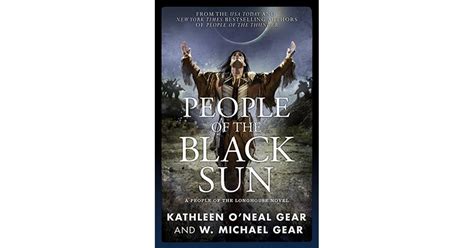People of the Black Sun by Kathleen O'Neal Gear and W. Michael Gear
ISBN: 978-0-7653-2695-9 
People of the Black Sun is in the genre of historical fiction. Really, a better category would probably be “Mythological Historical Fiction”. All of these labels fall under a much larger one, that one might simply call “Plausible.” Why all the caveats?
Well, for one thing, it is certain that the book hits upon what Native Americans believed and practiced. On the other hand, the only people who can really tell us what they believed and practiced are gone, and so one by necessity has to fill in some large blanks. Sure, there are smaller groups and individuals, but smaller groups and individuals are much different than large groups of people and their tribal, collective, history.
Nonetheless, the “Gears” do a good job inventing and extrapolating mythologies that are likely “close” to what the tribes believed. It is certain that a resource change or a “climate shift” caused the indigenous people of the Americas to have a reason to have inter-tribal conflict.
Our book opens nearly in the middle of the end of such a conflict, and tosses us into the gruesome scene of many hundreds of dead bodies and the kind of mortuary practices that took place to ensure that one’s enemies did not return from the “Great Beyond” to enact their vengeance. Along the way, our story centers on one specific Native American individual who survives a particularly extreme storm and seems to be a kind of Native American Prophet. This character, it appears, can see another woman who he knows, but it is not clear as to whether she is among the world of the living, or the dead. In the meantime, there are sorcerers afoot and witches, and issues with genetic authority and chieftains. The entire civilization is upended in the sense that only something like a book out of Revelation in the Bible can come close to describing.
Much of the rest of the book centers on the subsequent warring between tribes and whether the Prophet is in fact a Prophet, and what the exact nature of the woman he continues to see is. The tribes desperately need to stop infighting and find some manner of unity, so they can face the environmental challenges that are threatening to cause their extinction.
It is always a delicate operation for those that are considered to be “non-native” to undertake any work that concerns Native American history. It is likely that these two authors are “given a pass” to write about the subjects because they have PhD’s. Of course, colleges and those affiliated with college have also not been forthcoming about the actual history of many tribes, and so one is left to wonder exactly how much of the book is based on academic research and how much of it is based upon a kind of mythological fill-in-the-blank.
Either way, the book does well in describing a hypothetical Native American history, and does uncover some of the facts about what has been “forgotten”. This forgotten history is not especially described, but we are left to intuit how much of it is is actually the case and how much of it is “invented”. In that sense, one wishes one had the lines drawn more clearly, so one could “remember” whatever it was that was “lost”. One should not expect either of the Gears, however, to make this clear to them. Instead, one should look at their catalog of books which are “fictional” covering such historical topics. Who is it, that does not want our history remembered or deliberately told? This question is one that People of the Black Sun puts forward with a kind of force that only “Sky Messenger”–the main character in the book, might understand. 